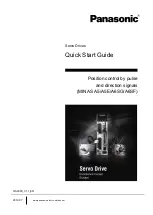
D
D
C
C
S
S
3
3
0
0
3
3
D
D
i
i
g
g
i
i
t
t
a
a
l
l
D
D
C
C
S
S
e
e
r
r
v
v
o
o
D
D
r
r
i
i
v
v
e
e
r
r
M
M
a
a
n
n
u
u
a
a
l
l
R
R
e
e
v
v
1
1
.
.
0
0
Tel: (86)755-26434369
38
Website: www.leadshine.com
Figure 6-30: Position following error curve and velocity curve (Kp=3000, Ki=250 and Kd=2000)
Increasing Kp a little and reducing Ki to 150 can achieve a faster response with little
overshoot, namely get a response close to Critically Damped response. See Figure
6-31. Remember to download the parameter settings to the driver
’
s EEPROM when
you get satisfying performances.
Figure 6-31: Position following error curve and velocity curve (Kp=3200, Ki=600 and Kd=4000)
D
D
C
C
S
S
3
3
0
0
3
3
D
D
i
i
g
g
i
i
t
t
a
a
l
l
D
D
C
C
S
S
e
e
r
r
v
v
o
o
D
D
r
r
i
i
v
v
e
e
r
r
M
M
a
a
n
n
u
u
a
a
l
l
R
R
e
e
v
v
1
1
.
.
0
0
Tel: (86)755-26434369
39
Website: www.leadshine.com
Figure 6-32: Position following error curve and velocity curve (Kp=3000, Ki=150 and Kd=2000)
Tuning servo systems formed by DCS303 drivers can be summarized as the
following rules:
1.
If servo system is UNSTABLE, then the first thing of tuning is to stabilize the
system. You can increase
Derivative Gain
of
Position Loop
(Kd) or decrease
Proportional Gain
of Position Loop (Kp) or
Integral Gain
of Position Loop
(Ki).
2.
If servo system is UNDER DAMPED, then increase Kd or decrease Kp or Ki.
3.
If servo system is CRITICALLY DAMPED, then stop tuning and download the
parameter settings to the driver
’
s EEPROM.
4.
If servo system is OVER DAMPED, then decrease Kd or increase Kp or Ki.
Remember that tuning the servo is to get satisfying performances, getting the best
performances of the servo is a time consuming work. So if the servo performance
can meet your application requirements, then the easier tuning way the better. Just
like if the performances of the products can meet your application requirements, then
the cheaper the better.




































